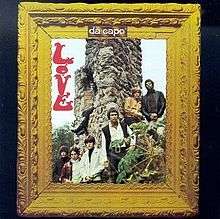Da Capo (Love album)
| Da Capo | ||||
|---|---|---|---|---|
 | ||||
| Studio album by Love | ||||
| Released | November 1966 | |||
| Recorded | September 27–October 2, 1966 | |||
| Studio | RCA Studios, Hollywood | |||
| Genre | ||||
| Length | 35:54 | |||
| Label | Elektra | |||
| Producer | ||||
| Love chronology | ||||
| ||||
Da Capo is the second studio album by the American psychedelic rock band Love, released in November 1966.
Recording
The bulk of Da Capo was recorded between September 27 and October 2, 1966 in RCA Studios, Hollywood.[1] "7 and 7 Is" was recorded on June 20, and had been released as a single in July 1966 backed with "No. Fourteen", an outtake from their debut album. After the recording of "7 and 7 Is", Love's line-up expanded to include Michael Stuart on drums and Tjay Cantrelli on saxophone and flute, moving previous drummer Alban "Snoopy" Pfisterer, a classically trained pianist, to harpsichord and organ. Guitarists Johnny Echols and Bryan MacLean, bassist Ken Forssi and vocalist and leader Arthur Lee retained their respective positions.
Da Capo encompasses the psychedelic rock[2] and baroque pop[3][4] genres. The album's first half is a departure from the group's debut, and in some ways anticipates the group's third album, Forever Changes, with its detailed, delicate arrangements. Abrasive, proto-punk rockers like "7 and 7 Is" and the harpsichord-driven "Stephanie Knows Who" are balanced by lighter fare such as MacLean's florid "Orange Skies", and playful, barely classifiable pop tunes like "¡Que Vida!"
The album's second half is a single track, notable for being among the very first rock songs to take up an entire LP side (Bob Dylan's "Sad Eyed Lady of the Lowlands" from Blonde on Blonde predated it by a few months, and The Mothers of Invention's "The Return of the Son of Monster Magnet" suite, on the Freak Out! album, followed Dylan's by just over a month). The 19-minute jam, entitled "Revelation" began life as a live showcase for the group. The introduction to the piece is the Giga from the Partita No. 1 BWV 825 by J. S. Bach. Some sources claim it evolved out of their interpretation of Howlin' Wolf's "Smokestack Lightning", yet its original title was "John Lee Hooker". The song/jam bears a resemblance to the Rolling Stones' "Goin' Home", recorded at the same studio (RCA) and released earlier in the year, on Aftermath. Arthur Lee is quoted on the back cover of Rhino's 1980 LP compilation "Best of Love": "The song "Revelation" was a long jam we did so the musicians could express themselves. The Rolling Stones saw us play at the Brave New World, and they recorded a long song on their next album. After our album came out, I got the blame for copying them!"
Reception
| Professional ratings | |
|---|---|
| Review scores | |
| Source | Rating |
| Allmusic | |
The album's critical reputation has suffered as a result of the inclusion of "Revelation", and many blame producer Paul Rothchild for failing to capture the group's live energy and truncating their performance. However, in a contemporary review of the album, critic Robert Christgau praised "Revelation" faintly for its "excellent guitar and harmonica work and great screaming by a lead singer (I don't know his name; the new style in record jackets is to reveal nothing)".[5]
Though "7 and 7 Is" had been a minor hit for the group; the album, like its predecessor, was a comparative flop, peaking at No. 80.
Track listing
All tracks composed by Arthur Lee, except where indicated.
- Side one
- "Stephanie Knows Who" – 2:33
- "Orange Skies" (Bryan MacLean) – 2:49
- "¡Que Vida!" – 3:37
- "7 and 7 Is" – 2:15
- "The Castle" – 3:00
- "She Comes in Colors" – 2:43
- Side two
- "Revelation" (Lee, Bryan MacLean, Johnny Echols, Ken Forssi) – 18:57
2001 reissue
The 2001 reissue presents both monaural and stereophonic mixes as well as a stereophonic tracking session for "7 and 7 Is".
Personnel
- Arthur Lee – lead vocals, harmonica, guitar, drums, percussion
- Bryan MacLean – rhythm guitar, vocal
- Johnny Echols – lead guitar
- Ken Forssi – bass
- Alban "Snoopy" Pfisterer – organ, harpsichord
- Michael Stuart – drums, percussion (On "7 and 7 Is", either Pfisterer or Lee plays drums. Stuart and Cantrelli do not appear.)
- Tjay Cantrelli – saxophone, flute, percussion
- with
- Dave Hassinger – engineer
- Bruce Botnick – engineer
Singles
- 7 & 7 Is/No. Fourteen (Elektra 45605)
- Stephanie Knows Who/Orange Skies (Elektra 45608, withdrawn)
- She Comes In Colors (edit)/Orange Skies (Elektra 45608)
- Que Vida!/Hey Joe (Elektra 45613)
References
- ↑ Paul Williams (2002). The Crawdaddy! Book: Writings (and Images) from the Magazine of Rock. Hal Leonard Corporation. p. 202. ISBN 978-0-634-02958-5.
- 1 2 Unterberger, Richie. "Da Capo: Allmusic Review". Retrieved June 15, 2012.
- ↑ Andrew Hickey (2 September 2012). Preservation: The Kinks' Music 1964-1974. Lulu.com. p. 61. ISBN 978-1-291-04932-9.
- ↑ Barney Hoskyns (1996). Waiting for the sun: the story of the Los Angeles music scene. Viking. p. 122.
- ↑ Christgau, Robert (June 1967). "Columns". Esquire Magazine. Retrieved August 1, 2006.